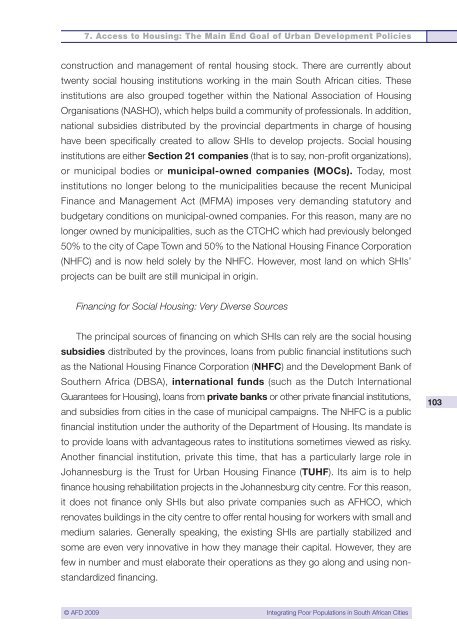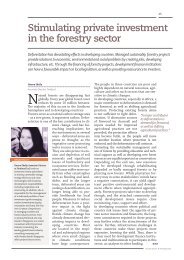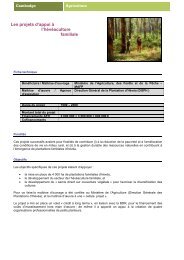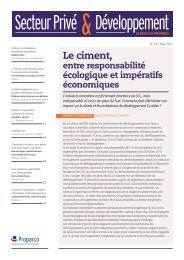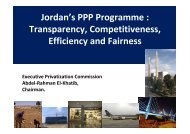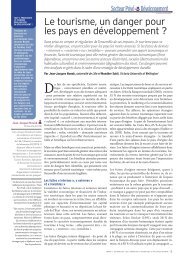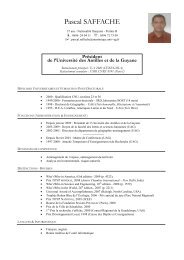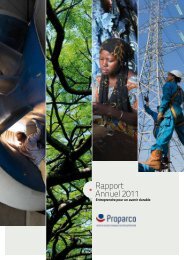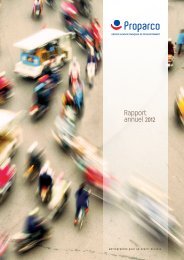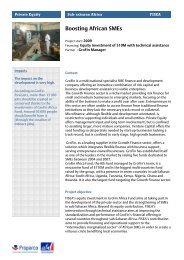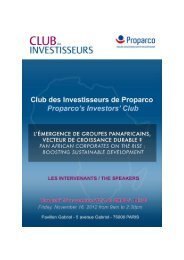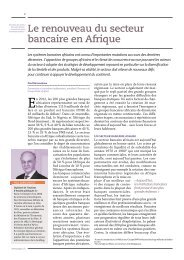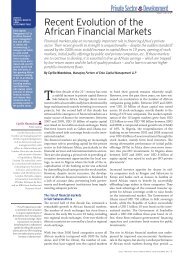Integrating Poor Populations in South African Cities - Agence ...
Integrating Poor Populations in South African Cities - Agence ...
Integrating Poor Populations in South African Cities - Agence ...
Create successful ePaper yourself
Turn your PDF publications into a flip-book with our unique Google optimized e-Paper software.
7. Access to Hous<strong>in</strong>g: The Ma<strong>in</strong> End Goal of Urban Development Policies<br />
construction and management of rental hous<strong>in</strong>g stock. There are currently about<br />
twenty social hous<strong>in</strong>g <strong>in</strong>stitutions work<strong>in</strong>g <strong>in</strong> the ma<strong>in</strong> <strong>South</strong> <strong>African</strong> cities. These<br />
<strong>in</strong>stitutions are also grouped together with<strong>in</strong> the National Association of Hous<strong>in</strong>g<br />
Organisations (NASHO), which helps build a community of professionals. In addition,<br />
national subsidies distributed by the prov<strong>in</strong>cial departments <strong>in</strong> charge of hous<strong>in</strong>g<br />
have been specifically created to allow SHIs to develop projects. Social hous<strong>in</strong>g<br />
<strong>in</strong>stitutions are either Section 21 companies (that is to say, non-profit organizations),<br />
or municipal bodies or municipal-owned companies (MOCs). Today, most<br />
<strong>in</strong>stitutions no longer belong to the municipalities because the recent Municipal<br />
F<strong>in</strong>ance and Management Act (MFMA) imposes very demand<strong>in</strong>g statutory and<br />
budgetary conditions on municipal-owned companies. For this reason, many are no<br />
longer owned by municipalities, such as the CTCHC which had previously belonged<br />
50% to the city of Cape Town and 50% to the National Hous<strong>in</strong>g F<strong>in</strong>ance Corporation<br />
(NHFC) and is now held solely by the NHFC. However, most land on which SHIs’<br />
projects can be built are still municipal <strong>in</strong> orig<strong>in</strong>.<br />
F<strong>in</strong>anc<strong>in</strong>g for Social Hous<strong>in</strong>g: Very Diverse Sources<br />
The pr<strong>in</strong>cipal sources of f<strong>in</strong>anc<strong>in</strong>g on which SHIs can rely are the social hous<strong>in</strong>g<br />
subsidies distributed by the prov<strong>in</strong>ces, loans from public f<strong>in</strong>ancial <strong>in</strong>stitutions such<br />
as the National Hous<strong>in</strong>g F<strong>in</strong>ance Corporation (NHFC) and the Development Bank of<br />
<strong>South</strong>ern Africa (DBSA), <strong>in</strong>ternational funds (such as the Dutch International<br />
Guarantees for Hous<strong>in</strong>g), loans from private banks or other private f<strong>in</strong>ancial <strong>in</strong>stitutions,<br />
and subsidies from cities <strong>in</strong> the case of municipal campaigns. The NHFC is a public<br />
f<strong>in</strong>ancial <strong>in</strong>stitution under the authority of the Department of Hous<strong>in</strong>g. Its mandate is<br />
to provide loans with advantageous rates to <strong>in</strong>stitutions sometimes viewed as risky.<br />
Another f<strong>in</strong>ancial <strong>in</strong>stitution, private this time, that has a particularly large role <strong>in</strong><br />
Johannesburg is the Trust for Urban Hous<strong>in</strong>g F<strong>in</strong>ance (TUHF). Its aim is to help<br />
f<strong>in</strong>ance hous<strong>in</strong>g rehabilitation projects <strong>in</strong> the Johannesburg city centre. For this reason,<br />
it does not f<strong>in</strong>ance only SHIs but also private companies such as AFHCO, which<br />
renovates build<strong>in</strong>gs <strong>in</strong> the city centre to offer rental hous<strong>in</strong>g for workers with small and<br />
medium salaries. Generally speak<strong>in</strong>g, the exist<strong>in</strong>g SHIs are partially stabilized and<br />
some are even very <strong>in</strong>novative <strong>in</strong> how they manage their capital. However, they are<br />
few <strong>in</strong> number and must elaborate their operations as they go along and us<strong>in</strong>g nonstandardized<br />
f<strong>in</strong>anc<strong>in</strong>g.<br />
103<br />
© AFD 2009 <strong>Integrat<strong>in</strong>g</strong> <strong>Poor</strong> <strong>Populations</strong> <strong>in</strong> <strong>South</strong> <strong>African</strong> <strong>Cities</strong>


